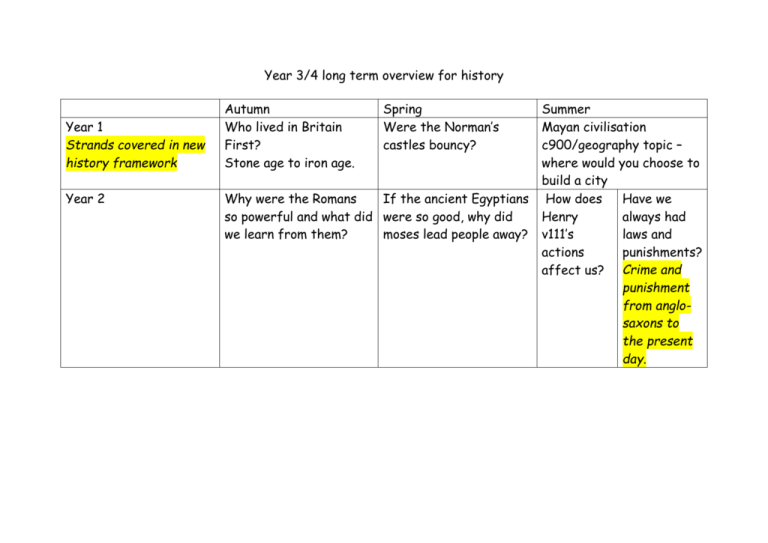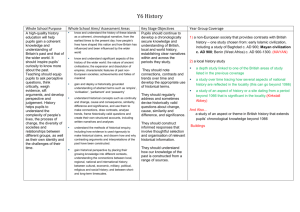Year 3/4 Overview and Assessment
advertisement

Year 3/4 long term overview for history Year 1 Strands covered in new history framework Year 2 Autumn Who lived in Britain First? Stone age to iron age. Spring Were the Norman’s castles bouncy? Why were the Romans If the ancient Egyptians so powerful and what did were so good, why did we learn from them? moses lead people away? Summer Mayan civilisation c900/geography topic – where would you choose to build a city How does Have we Henry always had v111’s laws and actions punishments? affect us? Crime and punishment from anglosaxons to the present day. Stone age to Iron age who lived in Britain first? Level Characteristic features of periods and societies Chronology Organisation and communication How the past is represented Identify reasons for events 2 Pupils understand that Britain was once covered in ice. They know that the earliest settlers were hunter-gatherers and lived in caves. Pupils can make deductions about lifestyle of Stone Age man from images. They can advance at least 2 reasons to suggest Stone Age man was interested in art and ceremonials. They can explain the impact of farming taming wild animals, growing wheat etc 3 They grasp hunter gatherers were living alongside early farmers 5000 years ago Pupils can locate the move to farming on a simple timeline. 4 Pupils grasp that discovery of Skara Brae was quite recent and that changed our view of early communities about 10,000 years ago. Pupils understand that it was built about 5,000 years ago, in stages. They can explain how it was built. Pupils can list 2 or 3 characteristics of life in an Iron Age hill fort community. Pupils can use their contextual knowledge of Iron Age hill fort life to speculate as to what might have happened. Some pupils can talk about relative significance of changes as well as continuities and can use precise language to describe periods of time e.g. Neolithic They use provisional and tentative language (might have, perhaps, possibly, maybe etc.) Pupils can make deductions about way of life by studying evidence of buildings left behind e.g. How do we know that the people living there were fishermen? How do we know that they ate pigs and cattle? How do we know that they grew crops? How do we know that their houses were dark? They can draw inferences from archaeological finds They understand that it was one of many similar constructions from that time. They can come to a conclusion as to the possible reasons for the bodies and substantiate their judgement using at least one piece of evidence. They can explain how artists’ impressions are created from fragments of finds. They can speculate as to likely use and come to a reasoned judgement using evidence. More able pupils can begin to weigh up the strengths and weaknesses of each theory. Assessment ideas/tasks Pupils are given five attractive colourful artist's reconstructions which clearly show different developments from Stone Age to Iron Age. Pupils will not have been shown these before. Independently they are asked: to sequence them, to explain their sequences (orally to you or TA) and to identify one really big change eg farming and explain why they chose it. The mark scheme shows what to expect from; below expectations, at national expectations, above national expectations, well above national expectations. Not a NC level in sight! The task can be carried out orally or you can ask some children to write their answers down. Were the Normans castles bouncy? Level Characteristic features of periods and societies I can describe the main events during the Norman period Chronology 3 I appreciate weapons have changed due to inventions and developments. 4 I understand wealthy people would have had a different way of living which would impact on their health and education. 2 Organisation and communication I can research two versions of an event and say how they differ. How the past is represented I recognise how lives in the past are different from ours. Identify reasons for events I can explain how events from our past have helped shape our lives I can plot recent history on a timeline using centuries. I can research what it was like for a child living in the Norman period . I can give more than one reason to support a historical argument. I can place periods of history on a timeline showing periods of time. I can use historical artefacts to help me understand more about British lives and the past. I know people in the past cooked and travelled differently and used different weapons from ours. I know items found from the past are helping us to build up an accurate picture of how people lived in the past. I can describe events and periods using the words BC AD and decade. I can give more than one reason to support a historical argument using evidence. Assessment tasks Mind map who are the Normans? When and where did they live? Post learning task chn to use small models recreate a battle or siege of a castle and film. Chn to act out characters in role and describe their characters. Film for evidence. Mayan civilisation c900 Level Characteristic features of periods and societies Chronology Organisation and communication How the past is represented Identify reasons for events 2 I can appreciate that some ancient civilisations showed greater advancements than people who lived centuries after them. I can appreciate that some ancient civilisations showed greater advancements than people who lived centuries after them. I can appreciate that some ancient civilisations showed greater advancements than people who lived centuries after them. I can use a timeline to fit a period of time in history I can summarise the main events from a specific period in history, explaining the order in which key events happened I can summarise what Britain may have learnt from other countries and civilisations through time gone by and more recently. I can recognise and describe differences and similarities between different periods in history. I can look at different versions of events and say how they are the same or different. I can suggest why there might be different interpretations of events. I can make links between different events in history I can identify and explain the use of propaganda. I can trace the main events that define Britain’s journey from a mono to a multi-cultural society 3 4 I can place a specific event on a timeline by decade I can place features of historical events and people from past societies and periods in a chronological framework. Assessment task Why do you think we study the Mayan empire? Post assessment What can you tell me about the Mayan empire? I can suggest relationships between causes in history

![afl_mat[1]](http://s2.studylib.net/store/data/005387843_1-8371eaaba182de7da429cb4369cd28fc-300x300.png)





